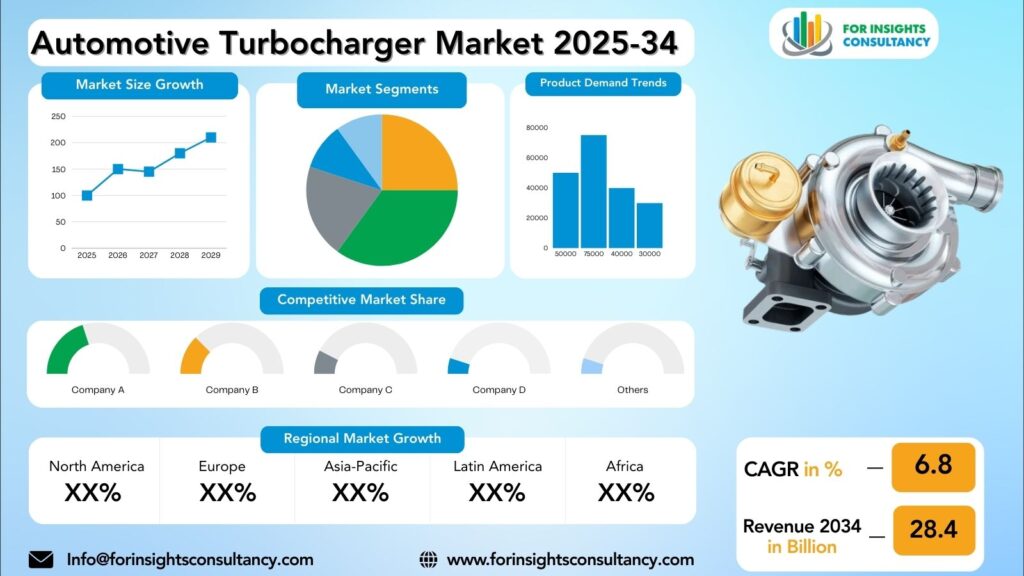
Automotive Turbocharger Market Research Report by Fuel Type (Gasoline, Diesel, Alternate Fuels (CNG/LPG, Hydrogen)), By Vehicle Type (Passenger Cars, Light Commercial Vehicles (LCV), Medium and Heavy Commercial Vehicles (HCV), Off-Highway Vehicles), by Technology Wastegate, Variable Geometry Turbocharger (VGT) / Variable Nozzle Turbine (VNT), Twin-Scroll, Electric Turbocharger), by Sales Channel, and by Region Global Market Analysis and Forecast, 2025-2034
July-2025 Formats | PDF | Category: Consumer Goods | Delivery: 24 to 72 Hours
Automotive Turbocharger Market is forecast to increase from USD 16.9 Billion in 2025 to USD 28.4 Billion by 2034, at a CAGR of 6.8%.
Automotive Turbocharger Market: A Comprehensive Overview and Future Developments
A turbocharger is a forced induction device that boosts an engine’s power output by forcing more air into the combustion chamber. It is powered by exhaust gases spinning a turbine connected to a compressor, which pressurizes the intake air before entering the engine. Key players in the automotive turbocharger market include Honeywell International, BorgWarner, Mitsubishi Heavy Industries, IHI Corporation, and Cummins. These companies are investing in research and development to improve turbocharger technology and meet the growing demand for fuel-efficient and high-performance vehicles.
The future of the automotive turbocharger market looks promising with advancements in materials, design, and electronic controls. Manufacturers are focusing on developing lightweight, durable turbochargers that can withstand higher temperatures and pressures, improving engine efficiency and reliability. The integration of artificial intelligence and machine learning algorithms will enable turbochargers to adapt to real-time driving conditions, optimizing performance and fuel economy. As vehicle electrification gains momentum, the automotive turbocharger market is exploring opportunities in hybrid and electric vehicles.
Automotive Turbocharger Market Dynamics
Growth Drivers
The demand for fuel-efficient vehicles is on the rise due to concerns over emissions and fuel efficiency. Automakers are turning to turbochargers to enhance vehicle performance by allowing smaller engines to produce more power, reducing fuel consumption. As governments tighten emission regulations, turbochargers play a crucial role in meeting these standards by improving engine efficiency and reducing harmful emissions. The trend of engine downsizing is also driving the demand for automotive turbochargers, as they enable smaller engines to deliver the same level of performance as larger ones while improving fuel efficiency. Technological advancements in turbocharging, such as variable geometry and electric turbochargers, are revolutionizing the industry and driving market growth. The increasing urbanization and infrastructure development in emerging markets is also driving the demand for vehicles, boosting the automotive turbocharger market.
Restraints
The automotive turbocharger market is facing several challenges, including market saturation, stricter emission regulations, technological advancements, and supply chain disruptions. Market saturation is due to the increasing competition from numerous players, leading to price wars and reduced profit margins for manufacturers. This makes it difficult for companies to invest in research and development for new products. Governments are also implementing stricter emission regulations, putting pressure on automakers to develop environmentally friendly vehicles. This has increased demand for turbocharged engines, but meeting these regulations requires significant investment in technology and engineering. Technological advancements have led to more efficient and powerful turbochargers, but they also pose challenges for manufacturers, especially smaller companies with limited resources. To stay competitive, companies must address these challenges and leverage technology to their advantage. Additionally, global supply chain disruptions like the COVID-19 pandemic have significantly impacted the automotive turbocharger market, with delays in production, shortages of raw materials, and transportation bottlenecks affecting the availability of turbocharger components.
Opportunities
The demand for electric vehicles (EVs) is increasing due to cleaner technologies, and turbochargers can be used in hybrid electric vehicles (HEVs) to improve performance and efficiency. The automotive turbocharger market is particularly lucrative in emerging markets like China and India, where rapid economic growth is boosting demand for vehicles with better performance and fuel efficiency. Companies can capitalize on this by developing lightweight and compact designs that offer improved performance without compromising efficiency. Innovation in turbocharger technology is crucial for staying ahead in the market. Additionally, collaboration with original equipment manufacturers (OEMs) can lead to long-term contracts and increased market share. By focusing on lightweight and compact designs, companies can stay ahead in the automotive turbocharger market.
Challenges
The automotive turbocharger market faces several challenges, including regulatory compliance, cost constraints, technology evolution, variability in demand, global supply chain disruptions, and competition from electric vehicles. Regulatory compliance is crucial as governments worldwide impose stricter emission regulations, necessitating the development of turbochargers that meet stringent standards. Cost constraints are another challenge, as turbochargers require advanced technology and precision engineering to balance performance, durability, and cost. Technology evolution also poses a dual challenge, as manufacturers must keep up with the latest advancements to stay competitive and meet customer demands.
Variability in demand is subject to factors like economic conditions, fuel prices, and consumer preferences, and market players must navigate this variability effectively to avoid overproduction or underutilization of resources. Global supply chain disruptions, such as natural disasters, geopolitical issues, or the COVID-19 pandemic, can lead to delays in production and increased costs. The rise of electric vehicles also presents a unique challenge, as the demand for traditional turbocharged vehicles may decline. Market players must adapt by exploring opportunities in the electric vehicle market or developing innovative solutions that cater to changing consumer preferences.
Automotive Turbocharger Market Top Companies Covered In This Report:
Evaluate The Strategic Positioning And Innovation Pipelines Of Leading Market Companies-From Multinational Enterprises To Disruptive Regional Firms. Understand How Key Players Are Innovating, Expanding, And Capturing Value, And Use Competitive Benchmarks To Plan Your Next Move.
- IHI Corporation
- BorgWarner Inc.
- Continental AG
- Garrett Motion Inc.
- Eaton Corporation PLC
- Honeywell International Inc.
- Mitsubishi Heavy Industries Ltd.
- Precision Turbo & Engine Inc.
- Rotomaster International
- THE TURBO ENGINEERS GmbH
- Fuyuan Turbocharger Co., Ltd.
- Marelli Corporation
- Turbo Dynamics
Automotive Turbocharger Market News
BorgWarner
In mid-2025, BorgWarner secured a strategic contract to supply turbochargers for a major North American OEM’s I4 and V6 engine platforms, used in their mid-sized and large SUVs and trucks. This win, along with an award to supply wastegate turbos for a global OEM’s hybrid sports car platform, highlights their continued relevance in traditional and hybrid powertrains.
Garrett Motion
At Auto Shanghai 2025, Garrett showcased its fifth-generation wastegate turbocharger specifically designed for plug-in hybrid vehicles. These turbos are optimized for low-viscosity oil systems and are engineered to help engines achieve thermal efficiency exceeding 45%.
IHI Corporation
IHI’s news in 2024 and 2025 indicated its focus on sustainability and diversifying its business, with a particular emphasis on hydrogen and other alternative fuels. While they have a strong turbocharger business, their public-facing announcements highlighted their efforts in ammonia and hydrogen combustion and a focus on industrial and marine applications.
Segmented View of the Industry:
The Automotive Turbocharger Market Is Mapped Through A Multidimensional Lens-Tracking Shifts Across Product Type, Applications, And Geographic Regions. This Segmented Approach Enables Businesses To Localize Their Growth Plans And Align Offerings With The Most Profitable Demand Centers.
Segmentation by Fuel Type
- Gasoline
- Diesel
- Alternate Fuels (CNG/LPG, Hydrogen)
Segmentation by Technology
- Wastegate
- Variable Geometry Turbocharger (VGT) / Variable Nozzle Turbine (VNT)
- Twin-Scroll
- Electric Turbocharger
Segmentation by Vehicle Type
- Passenger Cars
- Light Commercial Vehicles (LCV)
- Medium and Heavy Commercial Vehicles (HCV)
- Off-Highway Vehicles
Segmentation by Sales Channel
- Original Equipment Manufacturer (OEM)
- Aftermarket
Global Geographic Coverage:
The Report Provides In-Depth Qualitative and Quantitative Data On the Automotive Turbocharger Market For All Of The Regions And Countries Listed Below:
North America
The automotive turbocharger market in North America is experiencing robust growth due to factors such as increasing fuel efficiency standards, technological advancements, and consumer preferences for high-performance vehicles. Major automakers like Ford, General Motors, and Fiat Chrysler are incorporating turbochargers in their new vehicle models to improve fuel efficiency and performance. The aftermarket segment for turbochargers is also thriving in the US, with enthusiasts upgrading their vehicles for more power. Canada is another significant market for automotive turbochargers in North America, as the cold climate necessitates the use of turbocharged engines for better performance in cold weather conditions.
The government’s push towards lower emissions is also driving the adoption of turbochargers in the country. Mexico is an emerging market for automotive turbochargers, with a growing automotive manufacturing industry and international players setting up production facilities to cater to the increasing demand. As key players continue to invest in research and development, the market is poised for further expansion in the region.
Europe
Europe is a major market for automotive turbochargers, with Germany, the UK, France, and Italy leading the way in production and consumption. Germany is renowned for its high-quality vehicles and advanced engineering, with leading manufacturers like BorgWarner and Continental AG. The UK’s push towards cleaner and more fuel-efficient vehicles has led to increased production of turbochargers for hybrid and electric vehicles. Companies like Honeywell and Garrett Motion cater to the growing demand for turbocharged engines. France, with a focus on innovation and sustainability, is home to manufacturers like Valeo and Mitsubishi Heavy Industries, developing next-generation turbocharger technologies. The demand for turbocharged engines in France is driven by improved fuel efficiency and reduced emissions. Italy, known for its luxury sports car manufacturers like Ferrari and Lamborghini, has been early adopters of turbocharger technology. The Italian automotive market is characterized by a strong emphasis on performance and engine efficiency, making turbochargers a popular choice among car manufacturers.
Asia Pacific
The Asia Pacific region is a significant market for automotive turbochargers, with countries like China, Japan, and South Korea leading the way in innovation and production. China, the largest automotive market globally, is experiencing a surge in turbocharger penetration due to its rapid growth and government initiatives promoting vehicle electrification. Japan, known for its technological advancements and high-quality manufacturing standards, is a major hub for automotive turbocharger production.
Japanese automakers have been early adopters of turbocharging technology, incorporating it into various vehicles to improve performance and fuel efficiency. South Korea, known for its emphasis on quality and design, is another prominent player in the region, with a growing demand for turbocharged vehicles. As South Korean automakers expand their presence in international markets, the demand for turbocharged engines is expected to increase, driving the growth of the automotive turbocharger market in the region. Regional analysis is crucial for understanding the dynamics of the automotive turbocharger market, as each country presents unique opportunities and challenges for manufacturers.
Middle East and Africa
The Middle East region is experiencing significant growth in the automotive sector, with countries like Saudi Arabia, UAE, and Qatar leading the way in turbocharger adoption. This growth is driven by the increasing demand for fuel-efficient vehicles, government initiatives to reduce emissions, and the rise in disposable income and popularity of performance vehicles. Saudi Arabia’s high demand for passenger and commercial vehicles is fueled by the government’s push to diversify the economy away from oil dependency.
The UAE, with its well-established automotive industry and growing number of car enthusiasts, is another key market for automotive turbochargers. The country’s strong infrastructure and favorable government policies make it a lucrative market for automotive manufacturers. Qatar’s focus on sustainable transportation solutions and urbanization are driving the demand for turbocharged engines in both passenger and commercial vehicles.
The African automotive market is poised for growth, with countries like South Africa, Nigeria, and Kenya leading the way in turbocharger adoption. The increasing urbanization, rising disposable income, and growing awareness about the benefits of turbocharged engines are fueling the demand for these technologies in the region. South Africa has a strong presence of international auto manufacturers, while Nigeria is emerging as a key market due to rapid urbanization and increasing demand for commercial vehicles.
Kenya is also experiencing steady growth in the automotive sector, with a rising demand for passenger vehicles and commercial trucks. The government’s push towards sustainable transportation solutions and incentives for eco-friendly vehicles are driving the adoption of turbocharged engines in Kenya.
Reasons to Buy:
- The Research Would Help Top Administration/Policymakers/Professionals/Product Advancements/Sales Managers And Stakeholders In This Market In The Following Ways.
- The Report Provides Automotive Turbocharger Market Revenues At The Worldwide, Regional, And Country Levels With A Complete Analysis To 2034 Permitting Companies To Analyze Their Market Share And Analyze Projections, And Find New Markets To Aim For.
- To Understand The Most Affecting Driving And Restraining Forces In The Market And Their Impact On The Global Market.
- Major Changes And Assessment In Market Dynamics And Developments.
- The Objective Of The Automotive Turbocharger Market Report Is To Identify New Business Opportunities Using Quantitative Market Forecasts.
- Formulate Sales And Marketing Strategies By Gaining An Understanding Of Competitors, Their Positioning, And Strengths & Weaknesses.
Faq – What Global Leaders Are Asking
What Is The Growth Prospect For The Automotive Turbocharger Market By 2034?
Automotive Turbocharger Market Is Expected To Achieve A Stable Growth Rate With A Compound Annual Growth Rate (Cagr) Of About 6.8% From 2025 Through 2034.
What Is Driving The Growth Of The Automotive Turbocharger Market?
The growth of the automotive turbocharger market is primarily driven by global emission regulations that necessitate engine downsizing for improved fuel efficiency and reduced emissions. This is further fueled by the increasing production of hybrid vehicles, where turbochargers are essential for optimizing the performance of smaller internal combustion engines.
Who Are The Key Players In The Automotive Turbocharger Market, And What Are Their Market Shares?
The Automotive Turbocharger Market Includes Major Companies Like BorgWarner Inc., Continental AG, Garrett Motion Inc., Eaton Corporation PLC, Honeywell International Inc., Mitsubishi Heavy Industries Ltd., Precision Turbo & Engine Inc., Rotomaster International, THE TURBO ENGINEERS GmbH, Fuyuan Turbocharger Co., Ltd., Marelli Corporation, Turbo Dynamics, Others.
Specific Market Share Data Is Not Publicly Available and Is Typically Provided In Detailed, Proprietary Market Research Reports.
Which Regions Are Leading the Automotive Turbocharger Market Growth?
The Asia-Pacific region is the clear leader in the automotive turbocharger market, driven by its high volume of vehicle production and increasingly strict emission norms in countries like China and India. Europe also holds a significant market share, propelled by long-standing regulatory pressure and a strong automotive industry that is actively adopting new turbocharging technologies for both gasoline and diesel engines.
Customization: We Can Provide Following Things
1) On Market More Company Profiles (Competitors)
2) Data About Particular Country Or Region
3) We Will Incorporate The Same With No Additional Cost (Post Conducting Feasibility).
Any Requirement Contact Us: Https://Www.Forinsightsconsultancy.Com/Contact-Us/
Table of Contents
For TOC Contact us: https://forinsightsconsultancy.com/contact-us/







